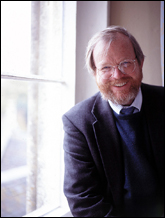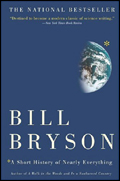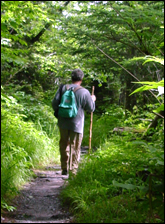Somewhere along the 2,200-mile trail from Georgia to Maine, through the Appalachian and Smoky Mountain chains, I fell in love with Bill Bryson.

A walk in the woods.
A Walk in the Woods, the venerable travel writer’s best-selling 1998 account of hiking a portion of the Appalachian Trail, conjured memories of adventures I’d had as a kid in the forests where I grew up. Bryson seems to capture my dueling feelings about the woods: beautiful and inspiring from a distance — “an America that millions of people scarcely know exists” — yet disorienting and at times menacing from within. “[The] trees surround you, loom over you, press in from all sides,” Bryson writes. “Woods choke off views and leave you muddled and without bearings. They make you feel small and confused and vulnerable, like a small child lost in a crowd of strange legs.”
This feeling of vulnerability he stirred in me only increased as I continued to read. While Bryson’s writing evoked familiar landscapes of my childhood, he also introduced me to some very adult realizations about land management. He caused me to question, for the first time, the U.S. Forest Service’s role in environmental protection: “A lot of people, seeing that word forest in the title, assume it has something to do with looking after trees. In fact, no … The Forest Service has the second-highest number of road engineers of any government institution on the planet. To say these guys like to build roads barely hints at their level of dedication. Show them a stand of trees anywhere and they will regard it thoughtfully for a long while, and say at last, ‘You know, we could put a road here.'”
I have a feeling I’m not the only reader who picked up Bryson’s books out of a passing interest in, say, hiking the Appalachian Trail, only to have my eyes opened and my skepticism sharpened. Whether he’s writing about the Australian outback in In a Sunburned Country, the dramatic geography of Kenya in African Diary, or life in America in I’m a Stranger Here Myself, Bryson’s voice becomes a sort of environmental conscience for unsuspecting readers. In my mind, his work could just as easily be shelved next to Wendell Berry and Terry Tempest Williams as Frommer’s and Lonely Planet. For many, Bryson is a writer to turn to when looking for direction in small-town America or the vast Australian desert. But for me, Bryson also serves as a quiet environmentalist, a writer who looks at a destination and describes not just where he is going but where the place itself has been — its natural history and the impact humans have had on it. The result is a vivid, multidimensional sense of the landscape and, in many cases, its frailty.

Bill Bryson.
Photo: English Heritage.
Take In a Sunburned Country, which opens with a long discussion of the vast, empty, and ancient nature of the island continent. In spite of that apparent emptiness, Australia is teeming with life, a good portion of which remains unknown to science. More than three-quarters of all plants and animals there have been found nowhere else, and Bryson makes a point of reminding readers that extinction looms dangerously large for many of these unique organisms. He mentions an unusual Australian frog that gives birth to its young through its mouth — something never seen anywhere else, and most likely never to be seen again: discovered by biologists in 1973, the species had disappeared by 1981 and is now listed as “probably extinct.”
Less about the natural beauty of a specific travel destination, I’m a Stranger Here Myself focuses on American culture as seen through Bryson’s eyes after 20 years of living abroad. He pokes fun at our love affair with the automobile and our apparent aversion to walking any distance — or being outdoors at all, really: “Cities across the nation have taken to building what are called skywalks — enclosed pedestrian flyovers, climate controlled of course — connecting all the buildings in their downtowns … Now it is possible to walk halfway to Omaha [from Des Moines, Iowa] without ever experiencing fresh air.”
In a chapter aptly titled “The Waste Generation,” Bryson asks why Americans are so happy to leave their appliances, car engines, and central heating on all the time (and “cranked up to a level that would scandalize a Finnish sauna housekeeper”). He notes that 5 percent of U.S. energy consumption can be attributed to computers left on needlessly, and asks, “Why, after all, go through the irksome annoyance of waiting 20 seconds for your computer to warm up each morning when you can have it at your immediate beck by leaving it on all night?”

A Short History of
Nearly Everything
by Bill Bryson,
Broadway Books,
560 pgs., 2004.
The Long and Short History of It
If Bryson indeed tasks himself with passing on an ethic of caring for the planet as he travels its continents, he takes that responsibility to new heights in his most recent book, A Short History of Nearly Everything, in which he takes a different type of journey — one that spans, well, nearly the entire history of science. This book isn’t for tourists hoping to see just one part of the world; rather, it’s for anyone seeking a greater understanding of the planet as a whole — from the birth of the universe to the evolution of human beings and everything in between.
That might seem like a tall order, but Bryson’s voice is at once so friendly, so informative, and so funny that it’s hardly like slogging through your 11th grade science textbook. Bryson expounds on such abstruse but influential ideas as relativity, Brownian motion, and superstring theory. Names like Albert Einstein, Louis Pasteur, and Marie Curie, as well as those not so readily recognized, are brought to life by Bryson’s detailed descriptions not only of these scientists’ work, but of their personalities and peculiarities. (Einstein, for instance, didn’t learn to speak until the age of three and failed his college entrance exams on the first try. Pasteur examined every meal placed before him with a magnifying glass. And Curie had a decidedly indiscreet affair with a married physicist, which kept her from being elected to the Academy of Sciences.)
In a political climate in which science as a whole is under attack, A Short History of Nearly Everything is a much-needed reminder of the contributions science has made — and of the mysteries it is still investigating. Bryson gives readers a big-picture view of how much we still don’t understand about our Earth, let alone our universe and the vast expanse of space that exists outside it.
In “Goodbye,” the final chapter of A Short History, Bryson begins with anecdotes about various species that have gone extinct at the hands of humans: the dodo bird, Steller’s sea cow, the passenger pigeon, and scores of others, many of which were never known to science at all. Even stuffed organisms, some representing the only specimen of an extinct species, have been known to disappear at the hands of humans. The last Carolina parakeet, stuffed after its death in 1918 at the Cincinnati Zoo, was lost some years later; the last surviving thylacine, the only large carnivorous marsupial to live into modern times, was thrown out with the weekly trash.
Bryson says he chose to include these stories to point out that humans are not necessarily the best choice for guardians and record-keepers of the planet. “But here’s an extremely salient point: we have been chosen, by fate or Providence or whatever you wish to call it. As far as we can tell, we are the best there is. We may be all there is. It’s an unnerving thought that we may be the living universe’s supreme achievement and its worst nightmare simultaneously.”
Unnerving indeed — and one reason to be grateful for Bryson’s work, which consistently and subtly reminds us of the importance of environmental stewardship. If the environmental movement seeks to recreate itself, reframing basic issues to reach a broader audience, we should look to writers like Bryson who are already making environmental issues not only palatable but deeply engaging. Perhaps we can, so to speak, take a page from his book. Make talking about the environment part of natural conversation. Make it part of a humorous story. Make it real and relevant in daily life. Make it so natural, in fact, that it is almost, but not quite, lost in the larger tale.


